
 |
Search | FAQ | US Titles | UK Titles | Memories | VaporWare | Digest | |||||||
| GuestBook | Classified | Chat | Products | Featured | Technical | Museum | ||||||||
| Downloads | Production | Fanfares | Music | Misc | Related | Contact | ||||||||
| Infrared Remote Control for All F/G CED Players | ||||||||||||||
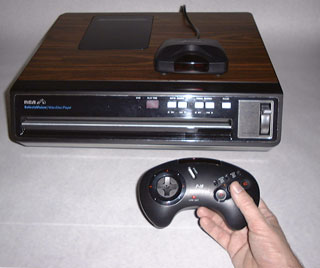 Pictured here is an RCA SFT100 VideoDisc Player being operated wirelessly with an infrared controller from a Sega Genesis video game system. The controller remotely provides all the front panel functions which include rapid access, visual search, and pause. In addition, the Sega controller provides the undocumented page mode in which the stylus repeatedly plays the same VideoDisc groove, resulting in something close to a freeze frame effect being displayed on the attached television. This remote also provides all these functions on the lowly SGT075 player, because even though that player has nothing but visual search, it still contains the same Mostek 3870 microprocessor found in all F/G players, and the processor is the true determinant of a player's functionality.
Pictured here is an RCA SFT100 VideoDisc Player being operated wirelessly with an infrared controller from a Sega Genesis video game system. The controller remotely provides all the front panel functions which include rapid access, visual search, and pause. In addition, the Sega controller provides the undocumented page mode in which the stylus repeatedly plays the same VideoDisc groove, resulting in something close to a freeze frame effect being displayed on the attached television. This remote also provides all these functions on the lowly SGT075 player, because even though that player has nothing but visual search, it still contains the same Mostek 3870 microprocessor found in all F/G players, and the processor is the true determinant of a player's functionality.
Detailed instructions are provided here for installing this remote control interface using a $5 build-it-yourself kit that includes all parts except the actual Sega Genesis controller and infrared receiver. These can be obtained by posting to the Usenet rec.games.video.sega group or by browsing through the Genesis Accessories category at eBay. In fact, most joysticks, joypads, and controllers with a 9-pin D-subminiature plug can be used with this interface. This includes the 9-pin devices from Atari and Sega video game systems up through the Sega Genesis and Sega CD. With roughly a twenty year history of the 9-pin video game connection being used, there is a large variety of controllers to choose from. But this page emphasizes the use of infrared controllers that emerged with the Sega Genesis game system around 1990, as most people building this interface will probably want an infrared interface rather than a wire running across the floor. I should mention that there is one Atari joystick that will not work- the Atari Wireless RF sticks. These controllers transmit by radio frequency, but they use a negative voltage system that is incompatible with CED players. A few manufacturers besides Atari and Sega also used the 9-pin D-subminiature plug, but with an analog interface or a different pinout. These incompatible units include the TI-99/4A, Intellivision, and Vectrex. The 9-pin D-Subminiature connection was also used as the RS-232 serial port on most personal computers from the late 1980's until the turn of the century. But these PC's used a larger 15-pin connector for their joysticks, which are incompatible with the CED remote interface.
To get an idea of how this interface works, take a look at the following two pictures showing a classic Atari 2600 joystick and the front panel of the RCA SFT100 CED Player.
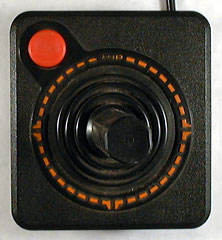
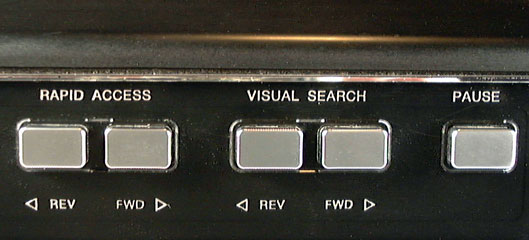
Although it may not immediately be apparent by looking, the Atari joystick contains five switches, one for the fire button and one for each of the four positions (up, down, left, right) of the stick. Likewise the front panel of the SFT100 has five switches corresponding to rapid access reverse and forward, visual search reverse and forward, and pause. All of these switches operate on the same principle where the switch closes a connection to ground when depressed. So all that is necessary to interface the joystick to the CED player is to connect the switches inside the joystick to the switches behind the front panel of the CED player. Someone who came home with a brand-new SFT100 player back in March 1981 could have borrowed a joystick from their Atari 2600 and prepared it by cutting the very end of the cable off. By soldering the exposed wires to the correct places inside the CED player, in a matter of minutes they could have had a remote control player, months before the Toshiba VP100 hit the market with its own wired remote.
But I strongly recommend using the instructions provided here rather than this simplistic direct wiring technique for several reasons:
This interface attaches directly to the Mostek 3870 processor inside the CED player, and it's bad design practice to connect an external device directly to a microprocessor without some sort of buffer in between. Without a buffer, any static discharge or dirty signal generated in the joystick is fed directly into the microprocessor, increasing the potential for damage. And if the custom-programmed MK3870 gets zapped, there's no alternative today but to get a replacement processor from another player. The buffer with my interface is a 7407 Hex buffer/driver integrated circuit.
The instructions here provide a 9-pin D-subminiature male socket on the player. Any joystick or controller with a 9-pin D-subminiature female plug can simply be plugged in and removed at will with no desoldering/soldering required.
Some wireless infrared receivers may not work when directly interfaced to the MK3870 processor. During my initial testing of the interface I found the Sega IR receiver when directly interfaced would work in Visual Fwd/Rev mode but not in Rapid Fwd/Rev. However, when the 7407 buffer was installed, all search functions worked normally. It might seem a mystery why this happened, but an examination of the circuit diagram below reveals what is going on. In Visual search mode the interface only has to drive a single pin of the MK3870 to a logic low, while in Rapid Access mode two pins of the chip must be driven to a logic low. This means the IR receiver has to sink twice as much current, and in the case of the Sega unit, it simply couldn't handle it. But the 7407 buffer can sink more than enough current to drive the dual pins to a logic low.
The diagram below shows the complete player side of the joystick interface starting with the D-Subminiature male connector at top and ending with the MK3870 microprocessor already inside the CED player at the lower right. The $5 kit provides all the components and connecting wire shown in the diagram except the MK3870 and the four 1N4009 diodes adjacent to it. These diodes are already present in all F/G players except the SGT075, but if you have that somewhat rare player, let me know when you order the kit and I'll include the four diodes. The inner workings of the 7407 Hex buffer integrated circuit are shown on the lower left, where adjacent pins on the device provide the input and output for each of the six separate buffers.
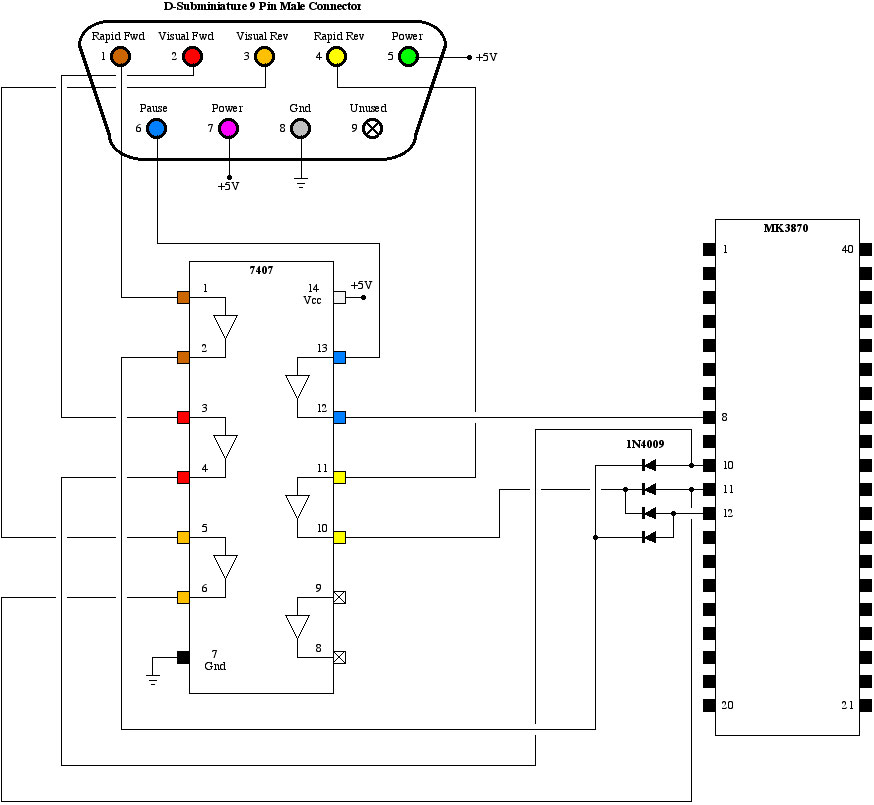
As an example of how the circuit works, take a look at Pin 1 of the D-Subminiature connector which controls Rapid Fwd. This pin leads to the input pin 1 of the 7407 buffer. A signal entering pin 1 exits from output pin 2, but in a cleaned-up state, i.e. the signal at pin 2 is either a logic high or logic low signal regardless of how noisy or high the input signal was. From pin 2 of the 7407 the signal connects to a juncture of two diodes on pins 10 and 12 of the MK3870 processor. When the system is at rest (i.e. no button on the controller is being pressed) pin 1 of the 7407 is at a logic high and as a result pin 2 of the 7407 and pins 10 and 12 of the MK3870 are also logic high. But when the Rapid Fwd button is pressed, pin 1 of the 7407 is connected to Ground (Gnd) which drives pin 2 of the 7407 to ground. In this state the buffer is sinking current which produces a voltage differential that turns on the two diodes adjacent to pins 10 and 12 of the MK3870. The flowing current from pins 10 and 12 drives them to a logic low, signaling the microprocessor to initiate Rapid Access mode. As soon as the Rapid Fwd button is released, all these pins float back up to a logic high, signaling the processor to resume normal speed playback.
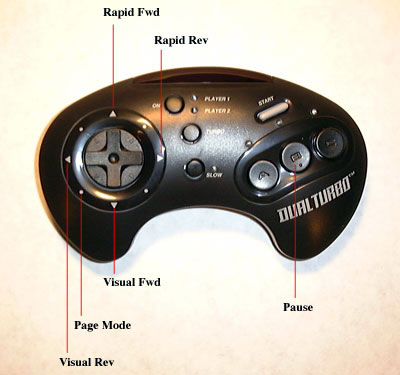
Shown here are the functions performed by the joypad and the "B" button when the interface is wired according to the schematic above. You can actually vary the functions anyway you want by switching the wires around prior to soldering them to the D-Subminiature socket. You'll notice that the joypad is wired so that the visual search functions (and likewise the rapid search functions) are wired to be adjacent to each other, when it might be more intuitive for them to be wired opposite each other. But the adjacent positioning was necessary to be able to implement the undocumented page mode function. Page mode is entered on F/G CED players when both visual search buttons are held down. A joypad or joystick is designed so that when it is positioned at one of the four 45 degrees positions (clockwise at 1:30, 4:30, 7:30, and 9:30) the two switches adjacent to that position are closed. This is how diagonal movement is achieved in video games. So with the CED remote both visual search buttons are simultaneously held down with a finger press at the 7:30 position. I believe that Visual Rev is the most common function used on a CED remote to replay the last few seconds of video or to review something that may have been missed. So Visual Rev was situated at 9:00, which is the most accessible position on the joypad.
The only button used is the "B" button for Pause, which corresponds to the Fire button on the earlier Atari joysticks. This functions the same way as Pause on the CED player front panel, i.e. one press initiates Pause and the next press initiates Play. The "A" button is available at pin 9 of the connector, so you may be wondering why I didn't use it for page mode. Implementing that would have required a more complicated circuit, and I wanted just one universal circuit that could be used with all Atari and Sega joysticks. When I get around to implementing this remote control for RCA's J/K players I may use the "A" button for Audio A/B or Reject. The "C" button (plus the other three game action buttons on some remotes) would require a considerably more complicated design, as their functions are multiplexed onto a single pin of the D-Subminiature connector.
Shown below are the wireless controllers that I have tried with this interface. So far I've seen six different brands of wireless Sega joysticks. These controllers all have a similar appearance with a 4-position joypad on the left and three or six game action buttons on the right. Of these, the Akklaim Dual Turbo is the most common and has the advantage of originally being packaged as two controllers and one receiver (as did some of the others). The Dual Turbo also has the advantage of the IR receiver circuit board being mountable on a LaserActive player, thus permitting the same controller to be used for both LaserDisc and CED. Most of the other IR receivers have short cords hanging off them. Either type will work with my interface, as the 9-pin socket on the player is on a short cord hanging out the back of the player. But if you want to drill an opening in the back of the player in which to mount the 9-pin socket, you'll want to get a corded IR receiver. The IR receivers have two 9-pin plugs (for two players), but the CED interface uses only one of these with the appropriate "Player 1" or "Player 2" switch being set on the controller. Note that these IR controllers and receivers are not mix and match- you have to use the controller with the matching receiver as they were originally packaged.
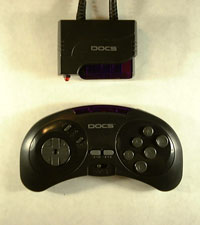 Docs
Docs
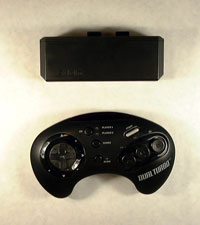 Akklaim Dual Turbo
Akklaim Dual Turbo
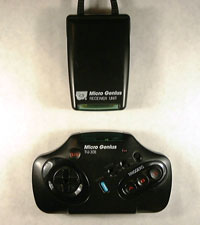 Micro Genius
Micro Genius
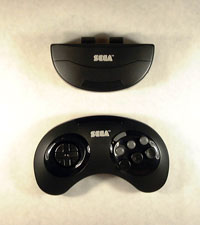 Sega
Sega
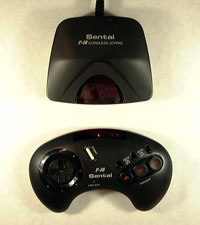 Sentai F-16
Sentai F-16
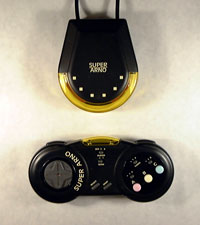 Super Arno
Super Arno
Since all the infrared controllers above post-date the CED era, I thought it would be interesting to include some of the wired controllers that were around when CED was on the market. There's a large variety of sticks available, owing to the extreme popularity of video games in the early 1980's, but most of my choices here are ones that can be operated with one hand. This is in contrast to the Atari 2600 OEM joystick shown near the top of this page, which requires you to hold the base in one hand while manipulating the stick with the other. My favorite one below is the Starplex Controller, which has a "Wood Grain" finish similar to the top of the Sears 274.54740150 CED player.
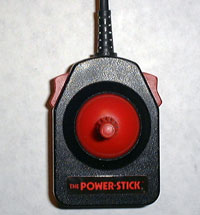 Amiga Power Stick
Amiga Power Stick
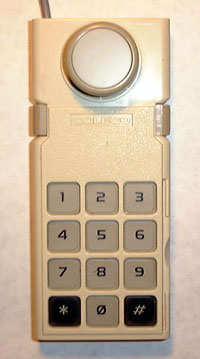 ColecoVision/Adam Joystick
ColecoVision/Adam Joystick
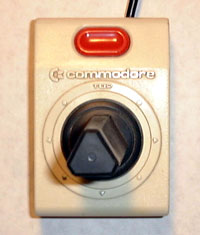 Commodore Joystick
Commodore Joystick
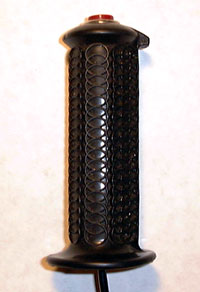 DataSoft Le-Stick Controller
DataSoft Le-Stick Controller
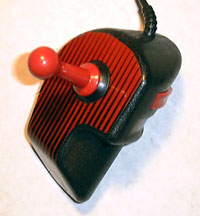 Konix Epyx 500XJ Joystick
Konix Epyx 500XJ Joystick
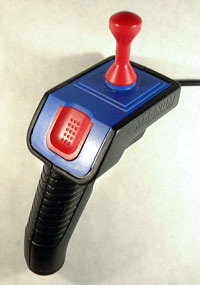 Magnum Joystick
Magnum Joystick
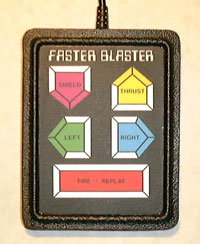 Transcriber Faster Blaster
Transcriber Faster Blaster
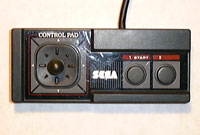 Sega Master System Pad
Sega Master System Pad
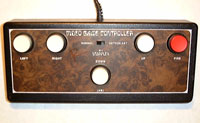 Starplex Controller
Starplex Controller
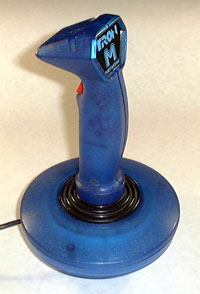 TRON Joystick
TRON Joystick